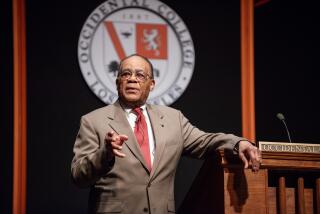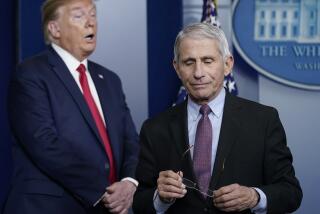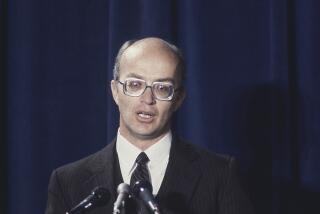Remembering the Great Vannevar Bush
- Share via
No formal ceremonies are planned, which is too bad. You won’t find his image on any currency or postage stamps. Even though he is the individual most responsible for America’s technological pre-eminence, he’s barely mentioned, if at all, in high school history texts. For what it’s worth, the National Science Board gives out a nice little medal and citation in his name.
This is the centenary year of Vannevar Bush, whose influence in virtually every facet of American science and technology--from policy to weaponry to education to electronics to medical research to computer software--is virtually impossible to overstate. He was an academic entrepreneur who co-founded Raytheon and was a vice president at the Massachusetts Institute of Technology who consolidated the school’s reputation as having the nation’s finest engineering program. It’s not just that Bush was a brilliant engineer; it’s that Bush knew how to map, build and manage the relationships and organizations necessary to get things done. He knew how to craft the human networks that could build the technological networks.
With the possible exceptions of James Shannon’s National Institutes of Health and James Webb’s National Aeronautics and Space Administration, nobody ever forged better alliances between industry, academe and government than Van Bush--or did so at such a crucial time. When Bush got President Franklin D. Roosevelt to approve the National Defense Research Committee (later the Office of Scientific Research and Development) during World War II, the United States was frighteningly behind the Nazis in both military technology and production capabilities.
Instead of the traditional route of launching government-owned and -controlled laboratories, Bush sanctioned an elaborate network of university/industry contracts to simultaneously research and develop critical technologies. (At OSRD’s height, Bush once guessed, roughly two-thirds of the nation’s physicists were working for him.) The British-pioneered technology of radar was perfected under this approach as was the proximity fuse. These and a host of other breakthrough technologies totally changed the face of the war. Implements of destruction weren’t OSRD’s only research focus; the agency also had oversight for military medicine, supervising the mass production of sulfa drugs and penicillin.
As head of OSRD, Bush was also Roosevelt’s key adviser in deciding to build the atomic bomb and determining the best way to go about it. Bush set up the scientific and technical infrastructure that the Army and Gen. Leslie Groves took over in 1943 under the Manhattan Project in Los Alamos. But they don’t make movies about the technocrats.
In his quirky and entertaining autobiography, “Pieces of the Action,” Bush ambiguously noted that his role was far more administrative than technical: “I made no technical contribution to the war effort,” he wrote. “Not a single idea of mine ever amounted to shucks. At times, I have been called an ‘atomic scientist.’ It would be fully as accurate to call me a child psychologist.”
As the war drew to a close, Bush--who had supervised the greatest mobilization of scientific and technical talent and resources the world had seen--turned his attention to what he thought would be the next great challenge for science. In a breathtakingly prescient article written for the July, 1945, Atlantic Monthly, Bush argued that the real post-war scientific challenge wouldn’t be eliminating poverty or disease but, instead, the management of information.
In “As We May Think,” Bush proposed a radical new technology to manage the torrents of new data. Decades before the personal computer could even be a glimmer in Steve Jobs’ eye, Bush suggested the idea of the “memex”--sort of an intelligent agent that could sort through masses of information and pluck out the relevant pieces. Even before the word “software” had been invented, this hard-core electrical engineer and Washington technocrat had intuitively grasped the conceptual keys to unlock the opportunities this information could provide.
Bush’s article presaged all the excitement surrounding hypermedia and multimedia you read about today. “As We May Think” remains one of the most cited articles in all of computer science. The same man responsible for launching the Atomic Age helped define the insights and vocabulary for the Information Age as well.
At President Harry S. Truman’s request, Bush drafted a memo, “Science: The Endless Frontier,” that served as a map for the federal government’s involvement in basic research and a blueprint for the National Science Foundation. Drawing on the historical Turner thesis that America defined itself by constantly pushing out to the frontiers, Bush asserted that the frontiers of science offered another way for America to define itself and create new wealth and opportunities for its citizens.
Nearly 45 years later, the crispness and vigor of Bush’s prose puts to shame the pantywaist posturings of today’s free-market idealogues and industrial policymeisters. Because Bush’s experience spanned the pinnacles of industry, academe, policy and public debate, he exuded a pragmatic legitimacy that mere bureaucrats, ivory-tower academics and profit-minded business people could only hope to aspire to.
As interested in the human machine as he was in mechanical and electrical gimcrackery, Bush served from 1957 to 1962 as chairman of Merck & Co., to this day one of America’s most highly regarded pharmaceutical companies--a firm that takes great pride in its levels of research, development and innovation. Bush’s essay on “The Art of Management” gives Peter F. Drucker a run for his money and underscores the point that great technology isn’t a byproduct of great science but of great people. Bush finished his professional career as the chairman of MIT.
I guess I shouldn’t be too surprised that there are no formal efforts to commemorate Bush and his contributions; America is a country that prefers to honor martyrs and events more than people who build enduring ideas and institutions. What surprises me is that, if you scan the landscape, there is no one that approaches the stature of Bush. We have visible scientists and engineers--not influential ones. We have people who would rather broker policy than forge it.
Why should this be so? It’s not that we don’t have people like Nobel laureate Leon Lederman, Intel co-founder and semiconductor pioneer Robert Noyce, double helix co-discoverer and human genome initiative leader James Watson and AIDS researcher Anthony Fauci who offer both breadth and depth in coping with the challenges of the day.
I think it’s that our existing institutions have become Himalayas of inertia and, unlike Bush’s day, there is no trump card of patriotism to play. What’s sad is that most of our existing infrastructure is more concerned with maintaining and expanding turf than building new organizations to cope with new opportunities. Instead of seeking new challenges or rising to old ones, people bicker about how much money is in their budgets.
One hundred years after the birth of America’s most effective technologist, we have a technological establishment that is more concerned with its own problems than with ours. Vannevar Bush left this country with a cornucopia of ideas and institutions that will long outlive him. It’s a pity that he didn’t leave us a few proteges.
More to Read
Sign up for Essential California
The most important California stories and recommendations in your inbox every morning.
You may occasionally receive promotional content from the Los Angeles Times.













